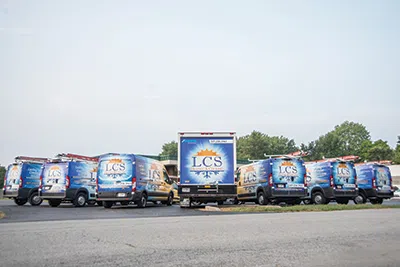If I said the terms kaizen, 5S, and visual workplace, you would probably think of manufacturing. These concepts have been used in leading manufacturing plants around the industrialized world for years. Did you know, though, that these concepts could help improve your hvacr business?
If you are skeptical, consider the story of Angie Alvarado, a district general manager for Sears Product and Parts Repair in Sacramento. This complete story, which is all about trucks, is available for download in the DOWNLOAD CENTER courtesy of Gwendolyn D. Galsworth, a consultant and visuality expert who worked with Alvarado and wrote Visual Workplace: Visual Thinking (Visual Lean Enterprise Press, 2005). There are plenty of photos and specific examples of visual improvements.
Here’s a synopsis of the results of the improvements the service team made: revenues increased $1.5 million in a year, customer satisfaction went up 300 basis points in the same year, and reschedules and cancellations dropped by 28,000. Within two years, the Sacramento unit became No. 1 in the nation, climbing from 47th place out of 67 Sears service units.
For those not familiar with the terms mentioned above, here’s a very brief explanation: kaizen is a Japanese term for short, focused efforts to make improvements; 5S is all about keeping things organized, neat, and safe — sort, shine, set in order, standardize, and sustain; and visual workplace is a concept that Galsworth promotes that means “a self-ordering, self-explaining, self-regulating, and self-improving workplace where what is suppose to happen does happen on time, every time, day or night — because of visual solutions.”
It’s hard to boil Galsworth’s concepts and methods down into one written column, but Alvarado does a great job in her testimony. Basically, Sears wanted to improve the productivity of its service teams because, as with most businesses, it was having to get more done with fewer resources. It was observed that the team members spent time looking for information, tools, and equipment in their trucks, which was time taken away from interacting with customers and concentrating on service. But instead of issuing standardized solutions for simply “being more organized,” the Sears unit allowed each technician to revamp his or her truck however desired, with a goal of making information, tools, and equipment have a designated location and label (Galsworth calls these “home addresses”).
“Some technicians labeled the racks with pictures of the parts; others made binders with diagrams of the truck interior,” Alvarado reports. “Most used color coding. . . We kept lots of supplies on-hand in the Visual Corner so techs could run with any improvement idea they thought of — bins, baskets, tape, pre-cut door pegboard panels, Velcro, hooks, and more.”
This effort at the Sears unit was about more than cleaning up sloppy truck cabs. It was about recognizing that each technician possessed the ability to make improvements and that the most valuable place to make these improvement was the workspace— literally where value is delivered to the customer.
It was about ownership and self-improvement as well. Morale soared, according to Alvarado, and productivity went up 15% because technicians were freer to interact with customers, recommending additional services and providing better follow-up.
And, from what Alvarado says, it made the workplace a more pleasant place.
“Trust was another unexpected result. Before visuality, we locked up pens and other supplies — because were certain that people would steal them. As a result, all managers had to have a ton of keys or know somebody who did. We don’t do that anymore. All supplies are in their addressed locations, open to anyone who needs them. Supplies don’t disappear. Employees don’t hoard. And the company doesn’t spend money on endless replenishments. People know where things are and they use what they need.”
The power of visuality is that it empowers employees to do their jobs more efficiently based on their own evaluations, ideas, and actions. It seems with this concept, everyone benefits, especially customers.
Tonya Vinas is a former editor of HVACR Business.


